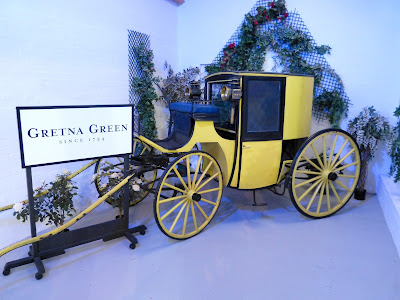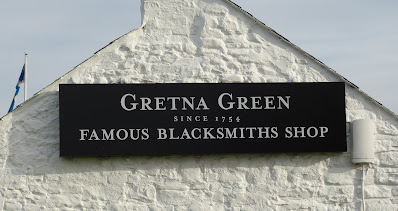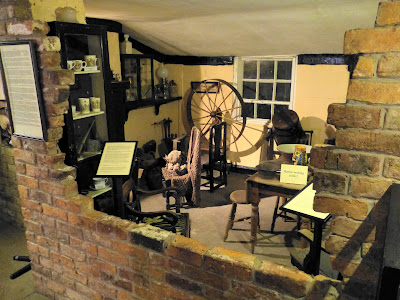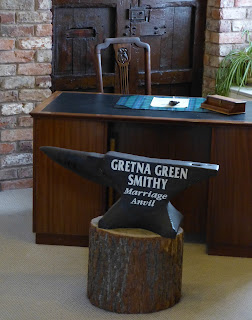 |
| Anvil in the main marriage room of the blacksmith's shop, Gretna Green (2015) |
Gretna Green is a village in the Scottish county of Dumfries and Galloway, just over the border from England.
What is so special about Gretna Green?
Gretna Green is famous for the huge number of couples who eloped there to get married. After Hardwicke’s Marriage Act came into force in 1754, couples under the age of 21 needed parental consent to get married. As this law did not apply in Scotland, couples who wanted to wed without this consent fled to the border and were married before their parents could stop them. As the first village in Scotland on the main post road from London, Gretna Green became a popular destination for eloping couples.
You can read more about why people ran away to Gretna in my earlier post: Why did Regency lovers elope to Gretna Green?
 |
| The blacksmith's shop, Gretna Green (2015) |
Many of the runaway couples were married over the anvil in the blacksmith’s shop. The handfasting (1) ceremony was conducted by one of the self-appointed ‘anvil priests’ who would bring his hammer down on the anvil as he completed the marriage ceremony. It was a very lucrative business. The eloping couples were typically well off and in such a hurry to get married that the anvil priest could charge a substantial fee for obliging them. Once the ceremony had taken place, the marriage was legally binding.
The anvil priests |
| The main marriage room in the blacksmith's shop, Gretna Green (2015) |
The most famous anvil priests during the Georgian period were:
Joseph Paisley (anvil priest 1754-1814)
Joseph Paisley was an ex-tobacconist and smuggler, renowned for his strength. He became a blacksmith, but quickly recognised that it was more lucrative to marry eloping couples and became one of the first blacksmith priests in 1754. Despite becoming immensely fat and addicted to drink, he continued to conduct marriage ceremonies until his death in 1814.
David Lang (anvil priest 1792-1827)
David Lang was Paisley’s nephew. He was pressganged into the British Navy as a young man and then captured by the American pirate John Paul Jones and made part of his crew. He escaped from Jones’ ship when it was near the Solway coast, swimming to the shore near Gretna.
In 1792, he became a rival blacksmith priest and was known as Bishop Lang because of the clerical style of dress he adopted. Like his uncle, he had a reputation for drinking too much. He was the anvil priest responsible for marrying Ellen Turner to her abductor, Edward Gibbon Wakefield, in the notorious Shrigley abduction and gave evidence at the trial in 1827. He died the same year.
 |
| David Lang - picture from the blacksmith's museum, Gretna Green (2015) |
Simon Lang (anvil priest 1827-1872)
Simon Lang was David Lang’s son and took over from his father in 1827. When the number of marriages started decreasing, he supplemented his income from the wedding business with weaving and smuggling, but he continued as an anvil priest until his death in 1872.
Robert Elliot (anvil priest 1814-1840)
Robert Elliot was a farmer’s son who worked for a stagecoach company. In 1811, he married Paisley’s granddaughter, Ann Graham, in the parish church at Gretna Green. He became Paisley’s assistant in the marriage business and took over from him on his death in 1814.
In his memoirs, Elliot claimed to have performed between 4,000 and 8,000 marriage ceremonies before he retired from the business in 1840. However, some of the other facts in his memoirs were clearly wrong, so it is hard to know how accurate this figure is and impossible to confirm one way or the other as his registers, and those of Paisley, were destroyed in a fire.
The end of runaway marriages
 |
| Travelling chariot in the museum at the blacksmith's shop, Gretna Green (2015) |
The number of eloping couples dwindled and Gretna Green’s once thriving marriage industry petered away.
The blacksmith’s shop gets a new lease of life
 |
| Sign on blacksmith's shop, Gretna Green (2015) |
It is unlikely that we would be so familiar with the Gretna Green story if it wasn’t for Hugh Mackie. Back in the 1880s, he bought the Gretna estate, including the famous blacksmith’s shop, and founded the family business which still runs Gretna Green today, promoting it as a romantic tourist spot.
The blacksmith’s shop remained a popular wedding venue until 1940 when an Act of Parliament made handfasting (1) ceremonies illegal, though some couples still liked to have a blessing over the anvil.
Today, the blacksmith’s shop at Gretna Green is once again in high demand as a romantic place to get married with over 1000 weddings taking place there every year. Scottish law now allows couples to get married over the anvil in either a religious or civil ceremony and, since the residency requirement no longer applies (2), Gretna Green is the obvious romantic destination for eloping couples.
 |
| Arch outside the blacksmith's shop, Gretna Green (2015) |
The blacksmith’s shop is part museum, part wedding venue. The museum is not expensive, but when I walked into the room initially, I was somewhat disappointed. There are a number of signboards telling the Gretna Green story, together with a couple of room sets (including one with a spinning wheel set up some years ago by my mother-in-law), a few costumes and various documents displayed on the walls.
 |
| The museum at the blacksmith's shop, Gretna Green (2015) |
 |
| A room depicting a household scene with a spinning wheel set up by my mother-in-law in the blacksmith's shop museum, Gretna Green (2015) |
At the end of the room is the way through to the anvil room. While we were parking our car, we saw one couple who had just been married, but by the time we were in the museum, another ceremony was already in progress. We were told that people were only allocated half hour slots!
Between weddings (there was another wedding group waiting to come in!), we had a few brief moments in the anvil room, enabling us to grab a few pictures. At this stage, I decided that the few pounds I had paid were probably worth it. After all, I had managed to see where the famous runaway weddings had taken place.
 |
| With my hand on the anvil at the blacksmith's shop, Gretna Green (2015) |
But there was more to come. Beyond the entrance to the anvil room, there were more marriage rooms, each with their own anvil. There are a lot of anvils in Gretna, both inside and out!
And the museum continued. There was a collection of horse-drawn vehicles, including a travelling chariot (shown above), a barouche, a Brougham and a stagecoach. I was not expecting this and it was a lovely surprise.
 |
| Another marriage room in the blacksmith's shop, Gretna Green (2015) |
 |
| Barouche, blacksmith's shop museum, Gretna Green (2015) |
 |
| Brougham, blacksmith's shop museum, Gretna Green (2015) |
 |
| Stagecoach, blacksmith's shop museum, Gretna Green (2015) |
Outside, there are various shops and the newest attraction—the Courtship Maze. Not much to look at yet, but I expect it will prove to be a nice addition to the complex when the hedges are fully grown.
If you are looking for a romantic and historic venue for a wedding, what better place than Gretna Green!
 |
| Entrance to Courtship Maze, Gretna Green (2015) |
Rachel Knowles writes clean/Christian Regency era romance and historical non-fiction. She has been sharing her research on this blog since 2011. Rachel lives in the beautiful Georgian seaside town of Weymouth, Dorset, on the south coast of England, with her husband, Andrew.
Find out more about Rachel's books and sign up for her newsletter here.If you have enjoyed this blog and want to encourage me and help me to keep making my research freely available, please buy me a virtual cup of coffee by clicking the button below.
Notes
(1) A handfasting ceremony simply required a couple to declare their intention to marry in front of witnesses and was a legal form of marriage in Scotland until 1940.
(2) The residency requirement established by the 1856 Marriage (Scotland) Act requiring at least one party to a marriage to live in Scotland for 21 days before the wedding could take place was abolished in 1977.
Sources used include:
Glasgow University website Gretna Green website
Parliament website
All photographs © regencyhistory.net



I loved this article! As my current book features an elopement to Gretna Green, it was most timely! I was there in 2005, but memories fade, and my photos weren't that great.
ReplyDeletei have read you post you have written very well about this places
ReplyDeleteRegards
Aana
I loved this article,i have read you post you have written very well about this places
ReplyDelete